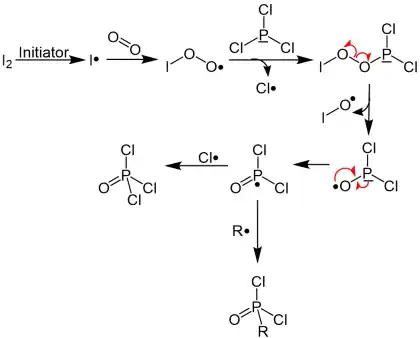Clayton-Jensen-Reaktion
Die Clayton-Jensen-Reaktion ist eine Namensreaktion der organischen Chemie. Die Reaktion wurde von J. O. Clayton, W. L. Jensen, L. Z. Soborovsky, Y. M. Zinovev, M. A. Englin und Roderich Graf erforscht. Als erstes berichteten jedoch Clayton und Jensen im Jahre 1948 von der Reaktion.[1][2][3]
Übersichtsreaktion
Bei der Clayton-Jensen-Reaktion handelt es sich um eine direkte Chlorophosphorisierung von aliphathischen Kohlenwasserstoffen mit Hilfe von Sauerstoff und Phosphortrichlorid.[1]

Die Ausbeute der Reaktion ist auf Grund der Kontamination durch oxidierendes Phosphortrichlorid sehr gering. Eine geringfügig höhere Ausbeute lässt sich durch einen erhöhten Kohlenwasserstoffeinsatz erzielen.[1][4][5][6][7]
Reaktionsmechanismus
Im vorgeschlagenen Reaktionsmechanismus beginnt die radikalische Reaktion auf Grund von Spuren eines Initiators im Kohlenwasserstoff spontan. Der Kohlenwasserstoff reagiert mit einem Chlorradikal zu einem Kohlenwasserstoffradikal.[1][4]

Auch die Entstehung des Iodradikals beruht auf den vorhandenen Initiator. Das Iodradikal greift ein Sauerstoffmolekül an. Das entstehende Radikal reagiert anschließend mit Phosphortrichlorid zu einem Zwischenprodukt, welches ein Hypoioditradikal abspaltet. Im letzten Schritt erfolgt eine Abbruchreaktion des Radikals, in dem es entweder mit einem Chlorradikal oder mit einem im ersten Schritt gebildeten Kohlenwasserstoffradikal reagiert. Somit entsteht ein Gemisch aus Phosphorylchlorid und Alkylphosophorylchlorid.[1][4]

Anwendung
Die Clayton-Jensen-Reaktion findet in der Synthese von Alkylphosphorylchlorid Anwendung.[1]
Siehe auch
- Clay-Kinnear-Perren-Reaktion
Einzelnachweise
- Zerong Wang: Comprehensive Organic Name Reactions and Reagents. John Wiley & Sons, Inc., Hoboken, NJ, USA 2010, ISBN 978-0-470-63885-9, S. 673–676, doi:10.1002/9780470638859.
- J. O. Clayton, W. L. Jensen: Reaction of Paraffin Hydrocarbons with Phosphorus Trichloride and Oxygen to Produce Alkanephosphonyl Chlorides. In: Journal of the American Chemical Society. Band 70, Nr. 11, November 1948, S. 3880–3882, doi:10.1021/ja01191a103.
- Roderich Graf: Über die Umsetzung von Alkanen mit Phosphortrichlorid und Sauerstoff. In: Chemische Berichte. Band 85, Nr. 1, 1952, S. 9–19, doi:10.1002/cber.19520850104.
- Frank R. Mayo, Lois J. Durham, Kyle S. Griggs: The Reaction of Alkanes with Phosphorus Trichloride and Oxygen. In: Journal of the American Chemical Society. Band 85, Nr. 20, Oktober 1963, S. 3156–3164, doi:10.1021/ja00903a023.
- A. Furman Isbell, F. T. Wadsworth: A Study of the Reaction of Hydrocarbons with Phosphorus Trichloride and Oxygen. In: Journal of the American Chemical Society. Band 78, Nr. 23, Dezember 1956, S. 6042–6045, doi:10.1021/ja01604a025.
- W. L. Jensen, C. R. Noller: The Preparation of Phosphonyl Chlorides by the Reaction of Hydrocarbons with Phosphorus Trichloride and Oxygen. In: Journal of the American Chemical Society. Band 71, Nr. 7, Juli 1949, S. 2384–2385, doi:10.1021/ja01175a040.
- R. L. Flurry, Charles E. Boozer: The Mechanism of the Chlorophosphonation of Hydrocarbons by Phosphorus Trichloride and Oxygen. In: The Journal of Organic Chemistry. Band 31, Nr. 7, Juli 1966, S. 2076–2083, doi:10.1021/jo01345a008.